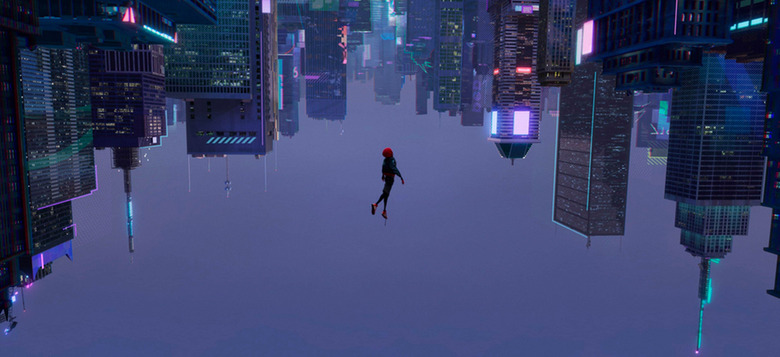'Spider-Man: Into The Spider-Verse': Here's The Technical Reason This Movie Looks So Incredible
Spider-Man: Into the Spider-Verse, which has earned rave reviews so far, is being hailed as the best animated movie of 2018. That comes down to a matter of taste, which makes the claim debatable. But here's something that's definitely not up for debate: this film doesn't look like any other animated feature.
So how exactly did directors Bob Persichetti, Peter Ramsey, and Rodney Rothman achieve that look? I sat down with them last week and asked them about their visual Into the Spider-Verse technique, and while the full interview will be published closer to the film's release, their answer to that question is worth highlighting now.
Spider-Man: Into the Spider-Verse Technique
At the movie's press junket, I spoke with Persichetti (The Little Prince), Ramsey (Rise of the Guardians), and Rothman (writer of 22 Jump Street) about how they pulled off that incredible new look.
***
For me, and maybe for some of our readers, we instantly know this movie is unlike anything we've ever seen before. But I've sort of been struggling to accurately describe the animation style. Can you pinpoint what you did specifically to give it such a special look?
Ramsey: Hired this man! (points at Persichetti, laughs)
Persichetti: Oddly enough, we struggle too trying to simplify it. At its core, we took the idea of traditional hand-drawn animation and the rules of that, and then took CG animation and blended them together. That's the super simple version of it. A little deeper in the weeds is that we had these characters modeled based off of drawings, and then once we did that, we realized some of the really expressive parts of the designs were actually the line work. We went in and figured out a way to draw line work on top of these characters three dimensionally, and then that line work could accept light if it needed to, or not.
Then the final thing that really makes it feel a lot different is, there's 24 frames a second in film, and in all CGI right now, there's a new image for every frame of movement. In traditional hand-drawn animation, you only needed twelve drawings to fill it up because your eye can't catch that little – you can hold a drawing for two frames, but if you hold a drawing for three, your eye can kind of catch the fact that it's being held. So we stripped out everything, we animated this on twos, and they had to write a bunch of new algorithms and things to try to make up for the lost simulations of all that stuff, like hair and cloth. But it really just makes it feel crunchy and crispy and –
Ramsey: Poppier.
Perschetti: Yeah, and poppier. And you get really strong posing. And then the final little reason why it's so crisp is that there's not one frame of motion blur anywhere in the movie. That's in every movie now. Even live-action with CG VFX, they put motion blur on it because it just helps soften it, and we were just looking for something that felt a little more punchy.
Rothman: Yeah, that approach basically makes the compositions stronger – or at least, that's the goal. Another way we talk about it is that it's basically combining CG animation, 2D hand-drawn animation, comic book art, and street art. We're trying to combine them into something that feels unified.
Spider-Verse Took Four Times Longer To Make Than a Typical Animated Feature
At almost every press screening, members of the press are given production notes with a description of how a project came together and several quotes from the filmmakers. One of the most interesting elements I learned while reading this film's notes is that during a typical animated film, it normally takes an artist about a week to animate four seconds of footage. But this film is so complicated that it took a week to animate only one second of footage. Not only that, but the shot count in Into the Spider-Verse is two to three times higher than most animated movies.
Here's a video featurette from Photoshop that gives a bit more insight into the process:
Spider-Man: Into the Spider-Verse arrives in theaters on December 14, 2018. Stay tuned for our full interview with the directors, as well as a conversation with producers Phil Lord and Chris Miller.

